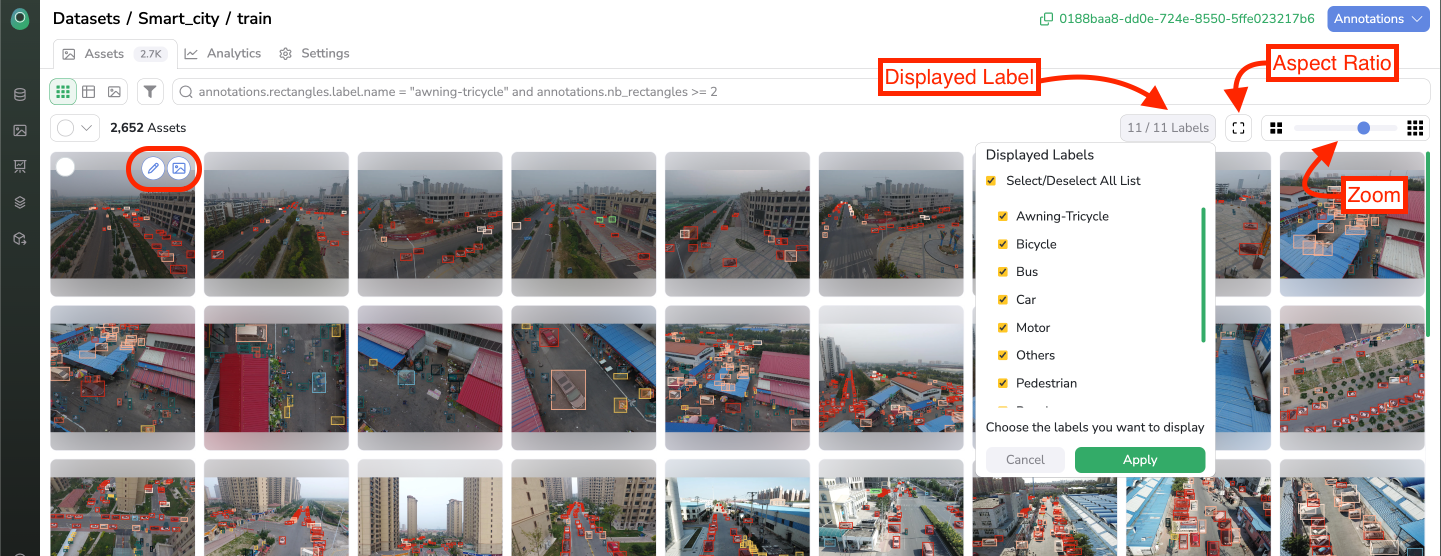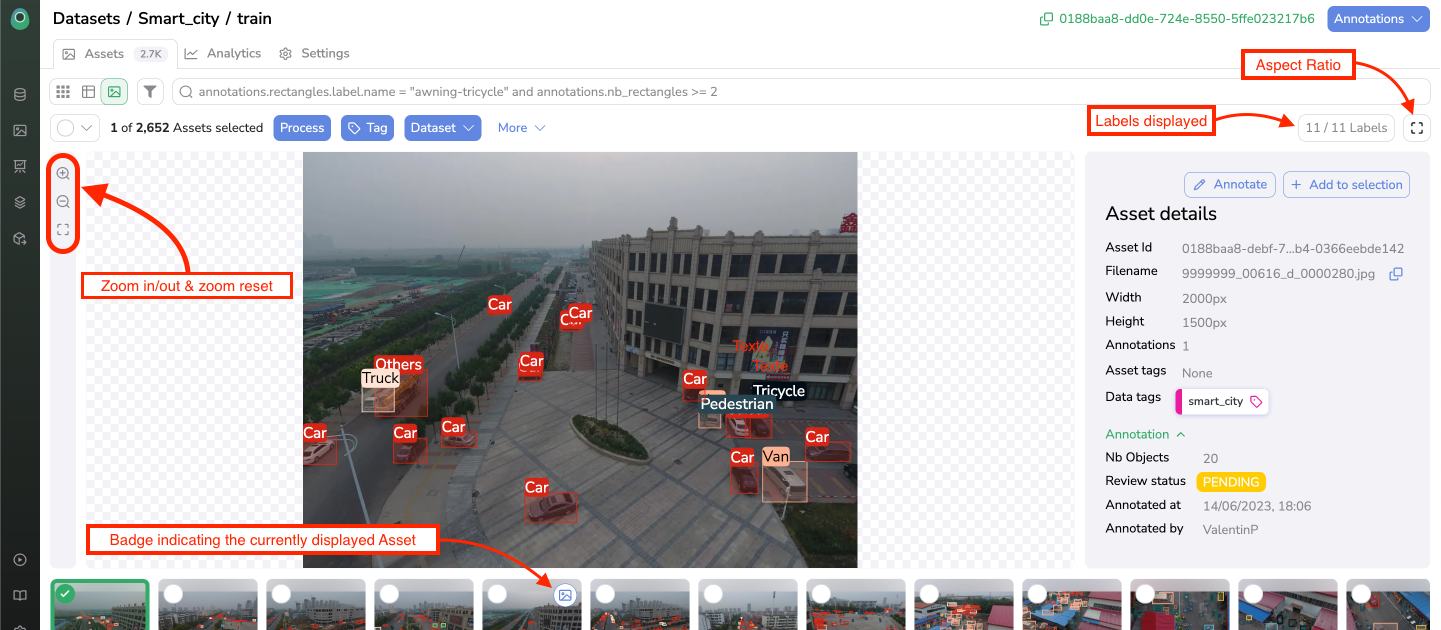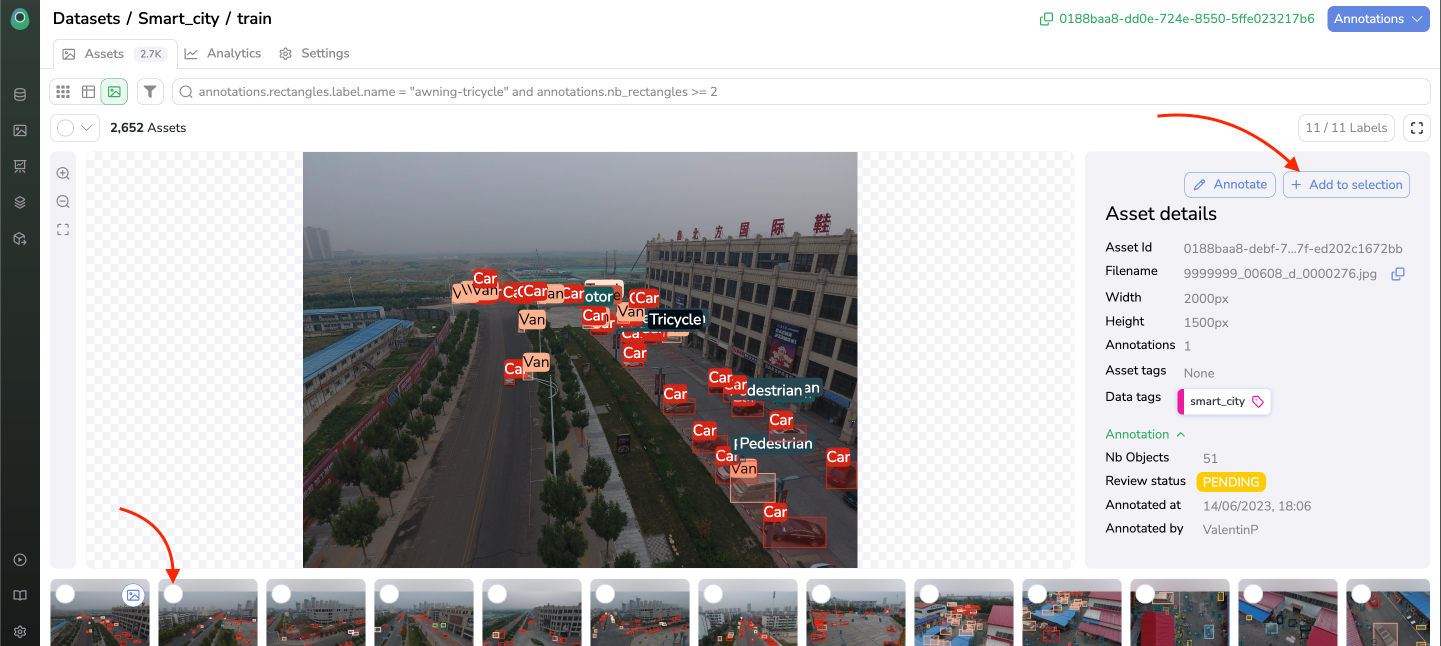Dataset - Assets overview
It is now time to visualize all the Asset composing a given DatasetVersion. When clicking on a DatasetVersion, the Assets overview opens.
Thanks to this view, you can very easily visualize all the Asset and associated Metadata composing your DatasetVersion. To have the best user experience browsing among your Asset, Picsellia offers you three different views:
- Grid view
- Table view
- Details view
On each view, you can for sure filter and order Asset the way you want.
The Assets overview is basically really similar to theDatalakeoverview.
1. Asset VS Data
Asset VS DataAs explained in the glossary, Data is an element of the Datalake that represents an image physically stored through a Storage Connector while an Asset is an element of a DatasetVersion.
However, an Asset is always related to Data which means that if an image is used in several DatasetVersion, we will have several Asset related to unique Data in the Datalake, it allows storing the image only once even if this one is used in many DatasetVersion.
Basically, the Metadata of an Asset inherits from Data ones, but an Asset also has additional Metadata that are related to the Annotation object.
It is important to know that an Asset can have Annotation whereas Data can't.
2. Asset visualization
Asset visualizationFrom the Assets overview, you can switch from one view to another easily using the following button:

Assets overview
The header of the view indicates Dataset and DatasetVersion names.
Loading time optimizationFor any view, images thumbnails are generated to ensure a fluid navigation and reduce a much as possible loading times.
A. Visualize Annotation and related objects
Annotation and related objectsOn the Assets overview, the potential Shape (classification, bounding boxes, or polygons) contained in an Annotation related to an Asset are displayed.
If Annotation exist they can be visualized through the different views available in the Assets overview.
Please note that to visualize an Annotation and its related Shape, the DatasetVersion type must have been set up and Annotation created on the DatasetVersion (either through Annotation import or through the Annotation tool)
More details about Annotation are available here.
AnAnnotationcan only be related to anAsset, not toData.
B. Grid view
The grid views allow visualizing at a glance many images from the DatasetVersion.
You can play with the zoom to adjust the number of images displayed by row and change the aspect ratio (among Square, Landscape, Portrait, and 16:9), to adapt the visualization to the format of your image.
In case the DatasetVersion is annotated, you can filter the Shape to display. You can hide/display Shape by Label. For instance, hide all the Shape with the Labelcar.

Grid view
Hovering on any image will display one badge allowing to vizualize the Asset in the Details view and one allowing to open the Annotation tool (pen icon)
Optimization for polygons visualizationIn case your
DatasetVersionis annotated with Polygons, in Grid mode the number of displayed polygons is limited to 50. Additionally, polygons with a very large number of points are not displayed.This behavior only affects the Grid view, all polygons are fully displayed in the Details view and in the Annotation Tool.
C. Table view
The table view mainly focuses on visualizing all the Metadata associated with images from the DatasetVersion.
Please note that the displayed Metadata are related to the Asset, not the linked Data. You can also notice that Annotations Metadata are available.

Table view
Switch to Details viewClicking on any image Preview will switch to the Details view of this image.
D. Details view
The details view aims to display all the elements from one particular Assetfrom the DatasetVersion, meaning the image is displayed in full and it's associated Metadata.
As for the Grid view, the aspect ratio can be chosen among Square, Landscape, Portrait, and 16:9. You will also be able to zoom in/out on the displayed image, and select the Shape to display based on the Label.

Details view
At the bottom of the view, the image gallery is displaying the thumbnails of the previous/next images in the DatasetVersion.
Metadata related to the Asset and potential Annotation are displayed on the right side of the view.
Left/right arrow keys allows a smooth navigation across images
3. Asset ordering
Asset orderingFrom any Assets overview, you can select the sorting button to access more sorting possibilities.

Open ordering features
The sorting features are then displayed. You can sort the Asset displayed in the Assets overview:
- Randomly
- By
AssetCreation Date (ascendant or descendant) - By File Name (ascendant or descendant)

Use ordering features
4. Asset selection
Asset selectionNow that we are able to visualize & sort all the Asset from the DatasetVersion. We will see how to select one or many of them to perform further action on them.
From any Assets overview, the selection of Asset can be done:
1 - Manually by checking the tickbox on each Asset (tickbox available on all views and Add to selection button available in details view)

Manual Assetselection
2 - By selecting all or the x first, displayAsset among your DatasetVersion:

Large Assetselection
The number of selected images against the total number of images currently displayed/filtered in the Datalake is displayed here:

Secleted Asset
OnceDataare selected, action buttons are displayed.
5. Asset deletion
Asset deletionTo delete Asset from your DatasetVersion, you need to select the to-be-deleted Asset, click on More > Delete assets:

Assetdeletion
Deleting anAssetonly delete it from the currentDatasetVersionIt means that the linked
Dataremains in theDatalakeand that any potential otherAssetlinked to the sameDatawill also remains in theirDatasetVersion.
Updated 6 months ago